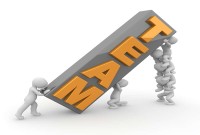- Home
- Business Processes
- Industry Knowledge
- Aerospace Industry
- Automotive Industry
- Banking Domain
- BFSI Industry
- Consumer/ FMCG Industry
- Chemicals Industry
- Engineering & Construction
- Energy Industry
- Education Domain
- Finance Domain
- Hospitality Domain
- Healthcare Industry
- Insurance Domain
- Retail Industry
- Travel and Tourism Domain
- Telecom Industry
- Leadership Skills
- eLearning
- Home
- Leadership Skills
- Problem Solving
- Benefits of Teams in Workplace
Benefits of Teams in Workplace
The use of formal work teams is commonplace in modern organizations. But why we have teams? What are the benefits or advantages that teams provide for organizations and employees? Do we really need to adopt formal team structures and use team-building approaches in organizations? Read this article to explore and learn the benefits of having formal teams in organizations.
There exist several organizational and individual benefits of using teams. These include increased workplace productivity; improvements to product/service quality; a reduced management structure; lower levels of absenteeism; reduced employee turnover; and increased industrial harmony, with all these benefits ultimately leading to improved workplace performance. It also enhances the quality of work-life (QWL) for employees and leads to increased work satisfaction. Teams are found in many workplace environments, including corporate, government, and education because they allow the organization to:
Organizational Benefits of Teams:
1. Workplace Productivity:
Having structured teams eliminate problems, waste and errors by removing variation in the work system by bringing individuals together to resolve work-system problems. The removal of variation in the work system produces a more productive system. Teams ensure that the work continues in the absence of a human ‘part’ by building ‘redundancy of parts’. This ensures that the system will not malfunction due to the absenteeism of any individual employee and will continue to perform without interruptions. Hence the organizations adopting team structures will have a higher level of labor productivity than firms that do not have these team structures.
2. Product/Service Quality:
As teams function to remove variation from a working system, resulting in the output being consistent and reliable. For example, in a production line work structure, employees focus on their individual ‘part’ in the system with quality generally inspected at the end of the production line. In the case of teams, a group of workers attends to whole tasks thereby ‘empowering’ such workers to take responsibility for their work and adjust work processes to improve the quality of their output. Hence the quality gets effectively ‘built-in’ to the process and therefore the organizations adopting team structure will gain higher levels of product/service quality than firms that do not have these team structures.
3. Lower Cost Management Structures:
By having teams, the responsibility for resolving work problems becomes collective and there is less need for external supervision. This reduced need for external supervision may result in a reduced number of levels in the hierarchy.
4. Lower Absenteeism:
Team structures provide an increased level of autonomy and responsibility and employees enjoying the social structure of teams are more likely to attend work. Thus, organizations with team structures will have lower absenteeism than firms that do not have these team structures.
5. Employee Turnover:
As with absenteeism, the social structure of teams is reported to positively impact employee turnover. If the quality of work-life is improved for employees when teams are present then a reduction in employee turnover is a likely outcome.
6. Industrial Harmony:
Teams actively encourage employees to present the results of problem analysis to management for approval regarding proposed solutions and this encourages improved labor-management interactions. Hence teams enable employees to have a closer working relationship with management which enables firms with these team structures to have a higher level of industrial harmony than firms that do not have these team structures.
7. Accomplish Big/Complicated Tasks:
Many organizational tasks and projects are too huge for an individual to do independently. Having team structures ensure that individual geniuses of the persons are collectively used and mammoth tasks are completed.
8. Brainstorm More Solution Options:
Different people looking at the same problem will find different solutions. A team can review ideas and put together a final solution that incorporates the best individual ideas. They can generate commitment for the final solution and work together to collectively pursue the same.
9. Review/Detect Flaws:
A team looking at different proposed solutions may also be in a better position to catch pitfalls that an individual might miss. This ensures that the final solution is much stronger and qualitative.
10. Build a Workplace Community:
Members of effective teams can form personal bonds which are good for individual and workplace morale. In the organizational setting, employees on teams may form bonds that extend beyond the work-place.
Individual Benefits of Teams:
1. Diversity:
Team structures provide exposure to different points of view. As the employees get exposed to methods and ideas that others have, they learn different ways of approaching a problem.
2. Enhanced Communication Skills:
Through teamwork training and practice, employees learn to actively and effectively listen to their team members to understand their viewpoints and concerns. A member needs to effectively articulate his ideas or your concerns to others to ensure they are taken care of or addressed. Members get genuine constructive feedback from each other and develop presentations, negotiating, and other related communication skills.
3. Critical Thinking and Evaluation Skills:
Team members must use these skills to evaluate the complex issues of team project goals and to formulate appropriate solutions and plans.
4. Conflict Resolution Skills:
Where there exists a diversity of ideas, there will naturally exist conflicts, but, with the right support and training in communication skills, team members can learn the skills to facilitate solutions to conflicts so that the team remains functional.
5. Higher Moral/Less Stress:
When things on the team are functioning well, it often results in higher morale and less stress at a personal level. Teams provide social support to team members and they can take help from each other in case of complex issues or other workplace-related problems.
Related Links
You May Also Like
-
Storming Stage of Team Development
Storming is the second stage of team development and this stage is characterized by a bid for power and inter-personal conflicts. Learn the key factors that occur in the storming stage and the strategies that a team leader can adopt to pass this stage of high winds
-
Tips for Effective Time Management
After studying and analyzing how time is spent, why time is wasted, and where time is wasted you need to decide about the changes required for effective utilization of time. For this purpose, a large number of remedial measures can be taken by you. The first and foremost determinant of a planned and purposeful utilization of time is to develop consciousness of the value of time at all levels of the organization. Planning, goal setting, and defining priorities are concerns to addressed immediately.
-
Team Development by Building Trust
As your team begins to work together, you need to establish a way each team member can exchange ideas and build mutual trust. Successful groups are built on trust and collaboration. A free exchange of ideas, in an open environment, will allow your team to get to know each other and enable you to check on how they work together. Learn some tips to help build team trust and establish personal bonds.
-
Team Foundation in Forming Stage
This is the first stage of team development. This is the stage when the foundation of the team is laid. During the Forming stage, team members have a high dependence on their leader for guidance. Learn the practical strategies you can use during this stage to help your team develop into a highly effective performing team.
-
Many different types of teams have been identified by social scientists. Managers may encounter the diverse types of challenges while managing different kinds of teams. Challenges associated with Cross-Functional Teams might be different from that of a Geographically Dispersed Team or a Virtual Team. This article explores some common categories and subtypes of teams.
-
Share Information with Your Team
Willingness to share information is the most critical and the very first step in the Journey to employee empowerment and team development. People cannot make good technology or business decisions without information. They need to understand the purpose behind what they are doing and connect with the big picture. People with information feel the need to take the risk of making decisions that enable business growth.
-
Recognizing Stress & its Sources
As an individual, you almost certainly know what stress feels like. Stressors are events or situations to which people must adjust. Stressors may be physical or psychological in nature. The level of severity of stress is determined not merely by exposure but the intensity, duration, and frequency of stressors. The sources of stress are many. They arise from multiple areas both with the individual and from the environment.
-
Process & Stages of Creativity
Creative ideas do not come just like that. There is a process to it. There are a number of techniques of creativity to support the generation of ideas but the widely practiced ones are brainstorming and lateral thinking. Most innovations are not so much the product of sudden insights as they are the result of a conscious process that often goes through multiple stages. The creative process can be divided into four stages of preparation, incubation, evaluation, and implementation.
-
Team leadership theory is a recent leadership theory that does not discriminate between the leader and the other team members. The approach considers contributions from each team member to be critical for organizational success. This approach focused on the overall team effectiveness and team problems are diagnosed and action is taken to remediate weakness. This approach provides for taking corrective action when the leader deems necessary.
-
Concept & Definition of Stress
Stress is a popular expression used by people in day to day life. Pressures of day to day living sometimes necessitate coping or dealing with them and stretch the body beyond its natural capacity. They are called stressors. Stress is a natural, ongoing dynamic, and interactive process that takes place as people adjust to their environment.
Explore Our Free Training Articles or
Sign Up to Start With Our eLearning Courses

About Us
Learning
© 2023 TechnoFunc, All Rights Reserved










